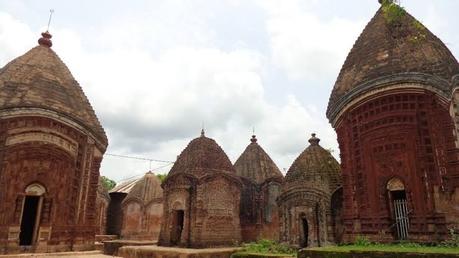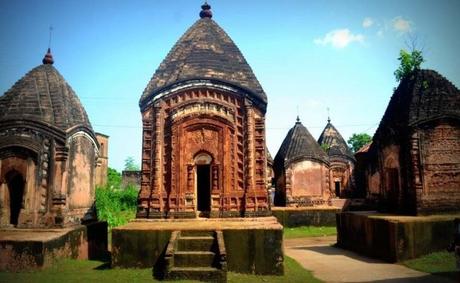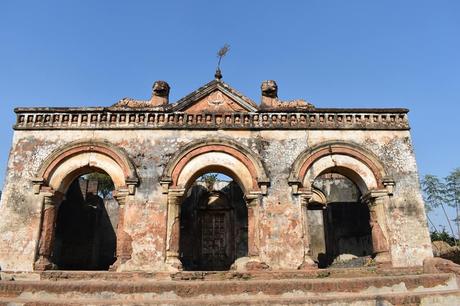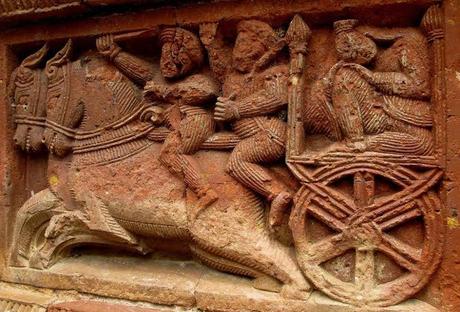Maluti, a small village located amidst the forest in the Dumka district of Jharkhand gained popularity during the reign of Alauddin Hussain Shah of Bengal in the 15th century. Keep reading to know more about history, 108 temples, architecture, the best time to visit, and lot more about the village of Maluti.
Table Of Contents
The Existence Of The Region
The village located in the Santhal Pargana region on the border of Jharkhand and West Bengal is said to exist since the Paleolithic period which is considered to be some 3.3 million years ago. To prove its existence, stone tools have been found in the riverbed of the river Chilla, which flows through the village separating Jharkhand from West Bengal. However, the area was never excavated to further study the site.
The Rise Of Maluti
The Sultan of Bengal and the founder of the Hussain Shahi dynasty, Alauddin Hussain Shah, ruled Bengal between 1494 to 1519. According to the tales, he was once hunting near Maluti with the queen when her favorite pet falcon (Baj in Bengali) got lost. The queen was quite upset and to make it up to her the king announced that he will pay a handsome reward to anyone who finds the falcon.
Hearing this, a Brahmin named Basanta Roy found the bird and returned it to the king. The Sultan was pleased by the boy and as promised he rewarded him with the tax-free region of Nankar.
Hence, Basanta Roy became the king marking the beginning of the Baj Basanta dynasty and also of the tax-free land known as Nankar Raj (tax-free kingdom). The King was awarded the prefix 'Baj' (falcon) as an honor and so, was later regarded as Raja Baj Basanta of Nankar Raj. He made Maluti the capital of his kingdom.
The Story Behind 108 Temples

Raja Baj Basanta was a religious person and believed in building temples instead of palaces. The king constructed many temples in his capital Maluti during his reign. He was succeeded by four sons but after his death, the family got separated into four clans. All the sons got one-fourth share of the kingdom.
The eldest son Rakharchandra as per custom became the king and his house came to be known as Rajbari (House of the king). The house of the second son was referred to as Madhyam Bari (House of the second).
The third son, Ramchandra's house was called Sikir Bari (House of one-fourth share) and the house of the fourth son Madhavchandra was called Chhai Taraf (House of six), as he was succeeded by six sons.
Each of the brothers kept building temples as a status competition and between the 17th to 19th-century Maluti turned into a unique village of 108 temples.
Terracotta Architecture
Terracotta has been used in the region of Jharkhand and West Bengal since long due to the availability of clay with no presence of stones. The brothers hired the Terracotta artisans known as Sutradhars to construct the temples.

Most of the temples have a Char-Challa architecture, huts having sloping roofs with curved edges, which is most common in Bengal while some of them have an Orissan architecture. All the 108 temples situated within a radius of 1150 ft is dedicated to Lord Shiva.
Apart from the shiva temples, the village also has 8 temples dedicated to Goddess Kali in different incarnations such as of the family deity, Goddess Moulakshi, and Goddess Manasa Devi. The walls of the temples tell the stories from the epics Mahabharata and Ramayana.
The Fall Of The Dynasty
Over the centuries, the royal family faced a financial crisis and was not able to provide money for the maintenance of the temples, as a result, 36 of the temple collapsed. Today, the remaining 72 temples along with the 8 temples of Goddess Kali survives in an endangered condition.
Maluti And Its Annual Animal Sacrifice
Maluti is known for its annual animal sacrifice of animals. It follows the tradition of sacrificing 100 goats, a buffalo, and a sheep on the occasion of Kali Puja. The village is facing a tough war from the animal activist to stop such practices.
The Tantric Influence

The village of Maluti is guessed by the experts to have been an important Hindu-Buddhist Tantric center and there are many reasons to back up the belief.
- The family deity, goddess Moulakshi has no reference in the Hindu mythology. It is believed that the goddess is referred to as the elder sister of Goddess Tara in Vajrayana also known as Tantric Buddhism.
- One among the 108 temples portrays Lord Shiva in the form of Bhairava, a tantric incarnation in Hinduism.
- Another temple is dedicated to Bamakhepa, or the 'mad saint' a Bengali saint who had great importance in Tarapith, a tantric temple in West Bengal. It is believed that he used to perform sadhana in the temple of Goddess Moulakshi to gain tantric powers. The villagers still worship him.
The Ill Faith Of The Temples
The district of Dumka has remained under the Naxal terror for many years. As a result, the temple village remained unknown to the rest of the country. It came into limelight in the year 1979, when a detailed report was published by Mr. A K Sinha, the Director of Archaeology, Government of Bihar. In spite of that, the department could not give attention to the temples due to highly violent Naxal activities in the region.
However, now due to the end of terror, the Government of Jharkhand along with The Global Heritage Fund has started conservation efforts to turn it into a major tourism site.
The Global Heritage Fund has declared it as a World's 12 Most Endangered Cultural Heritage Site.
Weather At Maluti
The area near Maluti has a subtropical humid climate. Summer starts from the month of March and prevails till the month of June. The temperature in the summer months ranges from 35 degrees to 45-degree centigrades. April and May are the hottest months of the year.
July to September is the monsoon season. Winter stretches from the month of November to February with the temperature fluctuating between 10-degree centigrades to 15-degree centigrades, December, and January is the coldest month.
Best Time To Visit Maluti
The best time to visit is during the winter months of November to February as the weather remains cool and pleasant.
Which Is The Nearest City To Maluti?
The nearest city to Maluti is the sub-capital city of Jharkhand, Dumka, located at a distance of 55.7 km via NH114A.
Which Is The Nearest Railway Station To Maluti?
The nearest railway station to Maluti is Dumka Railway Station (Station Code: DUMK), located at a distance of 57 km via NH114A.
How To Reach Maluti From Kolkata?
By Rail
Board a train from Howrah Junction to Dumka. The minimum journey time from Howrah toDumka is five hours by train. After getting down at Dumka, book a cab or auto to Maluti.
The distance between Dumka Railway Station to Maluti
By Road
You can self-drive from Kolkata to Maluti or book a rental cab
The distance between Kolkata to Maluti
- 220.9 km via Badshahi Rd/Grand Trunk Rd
- 254.5 km via NH19
- 248.5 km via NH114

By Air
You can not travel by air from Kolkata as the nearest airport is Netaji Subhas Chandra Bose International Airport, Kolkata.
Is Maluti safe for tourists?
Yes, Maluti is safe for tourists. Earlier it was a part of the Red corridor area but now, the government is turning it into a tourist hub. However, the following tips will help you to have a safe and sound visit.
Tips for visiting Maluti
- As it is located at a distance from the city, it becomes isolated after 4 pm, therefore, avoid visiting after sunset.
- Avoid visiting alone, always be in a group.
- The safest time to visit is between 6 am to 4 pm.
- It is much safer to visit during the peak season, i.e December to February.
- Carry water bottles, medicines, snacks, and other refreshments along.
Where to stay while visiting Maluti?
While visiting Maluti it is best to stay in Dumka. The city has both luxurious and budget hotels and lodges.

